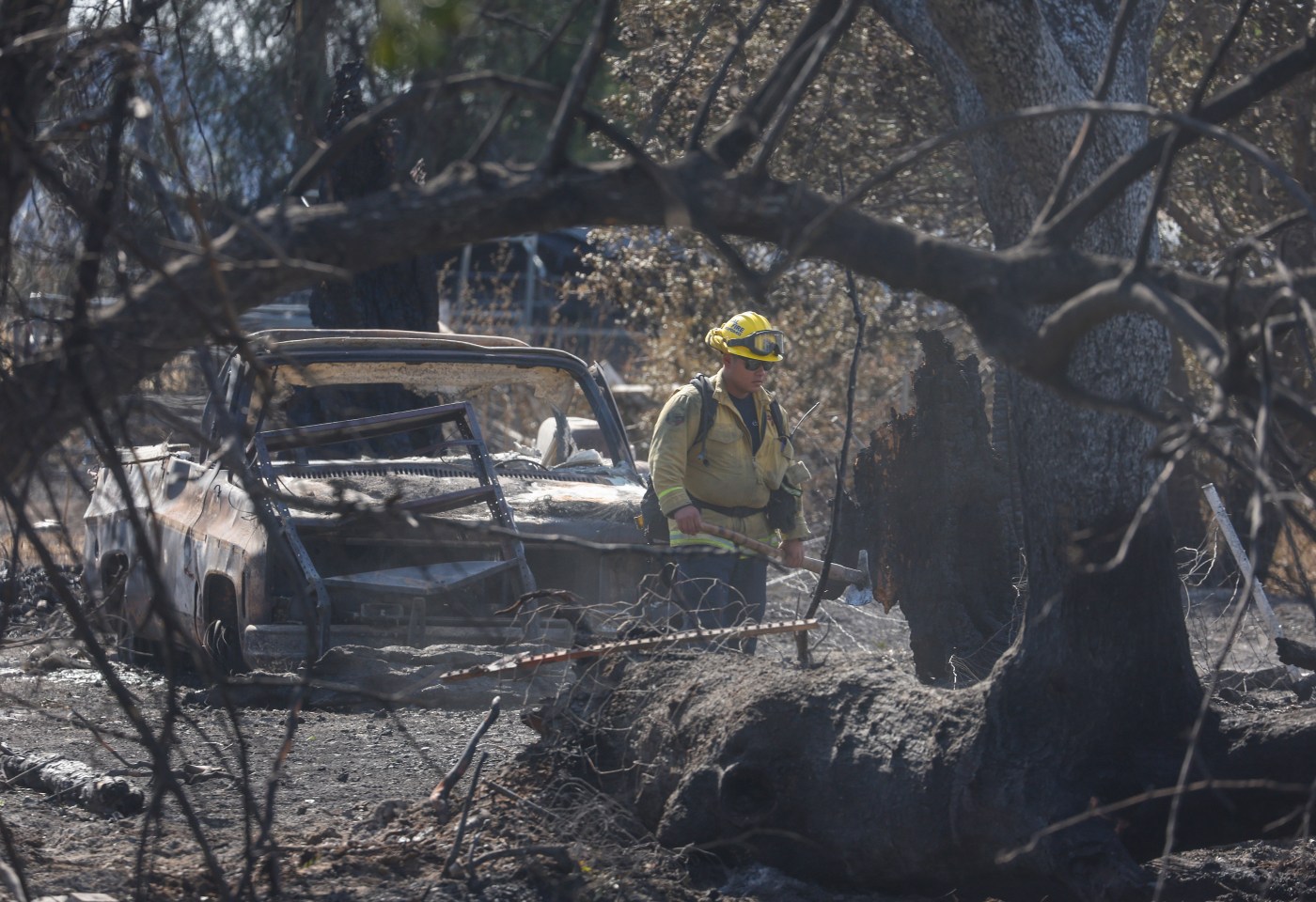Grass, meet spark. Bay Area residents, meet fire.
The explosive start to the 2024 fire season — the Corral Fire near Livermore that tore through rolling grasslands and rapidly scorched more acreage than the 1,253 previous California wildfires this year combined — heralds the types of blazes experts say residents of the Bay Area and elsewhere in Northern California can expect in coming weeks: fast-moving grass fires. What comes later depends largely on the weather.
Two wet winters in a row and the end of drought conditions have kept forested areas moist but fostered abundant growth of grasses that are now drying rapidly into beautiful, golden tinder.
“We’re seeing grass crops in excess of six to eight feet in some of our backcountry which is really going to make our fire suppression efforts tough in the Santa Clara Unit,” said Cal Fire Chief Baraka Carter, whose unit covers Santa Clara, Alameda, Contra Costa and western Stanislaus and San Joaquin counties. Parched, low-lying vegetation is vulnerable to the leap-frogging fire behavior that comes when the wind carries embers far and wide, Carter said. “Those fires are going to move really fast.”
While the Corral Fire, which sent two burned firefighters to hospitals, torched only one home, fire officials warn that flames could push into residential areas in many Bay Area neighborhoods bordering grasslands. The East Bay hills, San Jose’s Santa Teresa and Blossom Hill neighborhoods, communities around Mount Diablo, and uplands west of Palo Alto and Stanford University are some areas where an out-of-control grass fire could set homes ablaze, Carter said.
Three days before the Corral Fire blackened 14,000 acres in 24 hours, San Jose State University professor Craig Clements predicted that the greater Bay Area “should see an uptick in grassfires in coming weeks and in this week coming.” Such fires are usually easier to control than forest fires, said Clements, director of the university’s Wildfire Interdisciplinary Research Center.
Thanks to the moisture that heavier vegetation and trees are sucking up from well-saturated soils, the overall wildfire threat for the Bay Area, coastal areas and the Sierra Nevada remains below normal this month, and next, the National Interagency Fire Center reported early this month. The Sierra Foothills and Sacramento Valley are also facing normal wildfire threat levels.
In August, the Bay Area is expected to move into normal, meaning one to four forest fires of 100-plus acres or grassfires of 300-plus acres. Giant blazes are unlikely under conditions classified as normal, Clements said.
The Bay Area is also expected to see normal conditions in September, with one major fire likely or none, according to the National Fire Center. For coastal areas and the Sierra, heavy buildup of dried-out grass and shrubs and expected warm, dry weather in September may result in more than the usual number of significant fires, the center reported.
Clements cautioned that fire forecasts cannot fully capture the hazard, even when the threat is deemed normal. “We are still at high risk of fire throughout the summer because it’s day-to-day weather that plays a role in spreading fire,” Clements said.
As the summer progresses into fall, larger shrubs and trees dry out, boosting fire danger. “We don’t know what’s going to pan out in July if there’s a severe heatwave,” Clements said. “We don’t know how things are going to be in the fall.”
The coastal Pacific Ocean is moving from a strong El Niño into a moderate La Niña temperature pattern, which in past years has featured less-than-usual lightning and sent cool breezes sweeping inland from the Northern California coast in summer, keeping prolonged hot periods to a minimum, said U.S. Forest Service fire meteorologist Jeff Tonkin.
“We’re not expecting a really big fire season this year — at this point, anyway,” Tonkin said. “I’m not going to say we won’t have big fires. We’ll have some. It may not be five to eight or 10 like we saw a few years ago when we were under drought.”
Related Articles
Corral, Patterson fires 100% contained
Lax oversight by California agency put Interstate 10 at risk before 2023 blaze, audit finds
Patterson Fire and Corral Fire both nearly fully contained, Cal Fire reports
Crews battle new blaze northwest of Corral Fire
Eight-alarm fire destroys apartments under construction in North Fair Oaks
In coastal zones of San Mateo and Santa Cruz counties, significant fire risk may arise through the summer at higher elevations where the fog and cool air of the marine layer burn off early in the day, said Cal Fire Chief Nate Armstrong.
The vast majority of wildfires are human-caused, most of them by accident, such as when people create sparks by mowing, drag connecter chains from RVs, or fail to douse campfires, according to Cal Fire. People caused nearly 3,000 wildfires in Northern California last year, the National Interagency Fire Center reported.
Cal Fire is now conducting intensive firefighter training and vegetation reduction, as staff will soon be too busy fighting fires, Armstrong said. In the Santa Cruz Mountains, lush plant growth has choked off access roads firefighters may need, and because of windstorms over the winter, “we have a lot of dead material on the forest floor,” Armstrong said.
On the Bay Area side of those mountains, Steve Cottrell, 59, has lived 18 years on a forest- and scrub-covered Los Gatos hillside uphill from The Cats restaurant beside Highway 17. The 2020 CZU Lightning Complex firestorm north of Santa Cruz that burned 85,000 acres, including huge swathes of redwood forest, put him on higher alert.
“It gets a little sketchy,” said Cottrell, a painting contractor. “The weeds get high, and then it all gets brown, and that’s when you start to worry.”
Cottrell said his landlord, a retired firefighter, diligently clears flammable vegetation from the area around his house. Fire officials want Bay Area residents to do the same.
“Most people probably don’t think it’s an issue until their home is being threatened,” said Cal Fire’s Armstrong. “Asking everyone to do their own part is really kind of our biggest thing. It’s a shared responsibility.”
Berkeley Hills resident Michael Scharff takes the threat of fire seriously — for the sake of his family, his neighbors and his 1907 wood-framed home designed by famed architect Bernard Maybeck of the San Francisco Palace of Fine Arts. When the Scharffs moved in five years ago, they removed about 20 trees and lots of shrubs, and “tried to make it as clean as possible from a fire-safety standpoint,” said Scharff, 60.
The home barely escaped the devastating 1923 Berkeley wildfire and is subject to annual fire inspections. “We’ve done everything the fire department has asked us to do and more, creating defensible space around the house, and thinning trees, keeping plants away,” said Scharff, a “semi-retired” software executive.
The Scharffs attend annual meetings of a north Berkeley fire-safety group dedicated to hardening entire communities against the spread of wildfire.
“It really has to be a neighborhood approach,” Scharff said.












